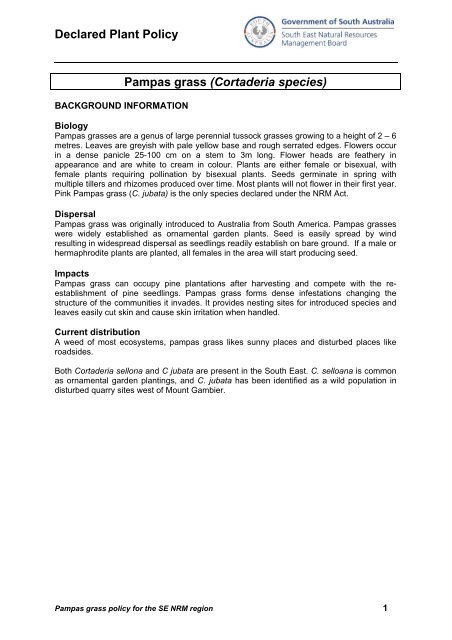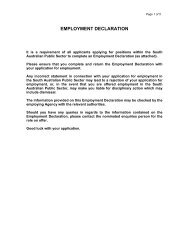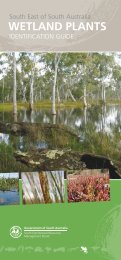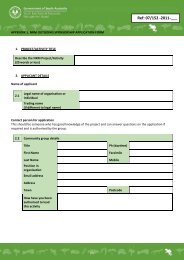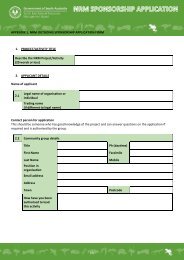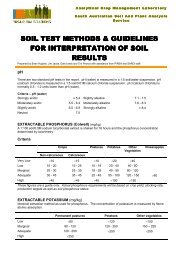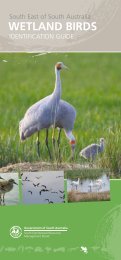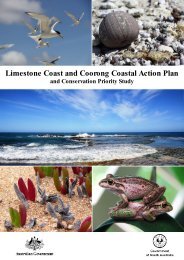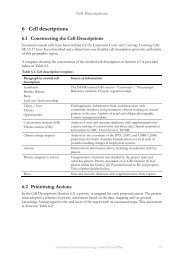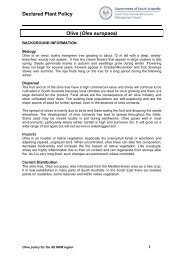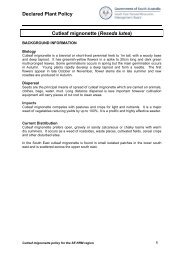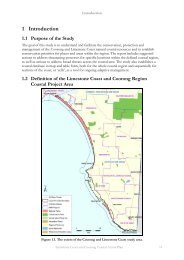Pampas grass policy - South East Natural Resources Management ...
Pampas grass policy - South East Natural Resources Management ...
Pampas grass policy - South East Natural Resources Management ...
Create successful ePaper yourself
Turn your PDF publications into a flip-book with our unique Google optimized e-Paper software.
Declared Plant Policy<br />
BACKGROUND INFORMATION<br />
<strong>Pampas</strong> <strong>grass</strong> (Cortaderia species)<br />
Biology<br />
<strong>Pampas</strong> <strong>grass</strong>es are a genus of large perennial tussock <strong>grass</strong>es growing to a height of 2 – 6<br />
metres. Leaves are greyish with pale yellow base and rough serrated edges. Flowers occur<br />
in a dense panicle 25-100 cm on a stem to 3m long. Flower heads are feathery in<br />
appearance and are white to cream in colour. Plants are either female or bisexual, with<br />
female plants requiring pollination by bisexual plants. Seeds germinate in spring with<br />
multiple tillers and rhizomes produced over time. Most plants will not flower in their first year.<br />
Pink <strong>Pampas</strong> <strong>grass</strong> (C. jubata) is the only species declared under the NRM Act.<br />
Dispersal<br />
<strong>Pampas</strong> <strong>grass</strong> was originally introduced to Australia from <strong>South</strong> America. <strong>Pampas</strong> <strong>grass</strong>es<br />
were widely established as ornamental garden plants. Seed is easily spread by wind<br />
resulting in widespread dispersal as seedlings readily establish on bare ground. If a male or<br />
hermaphrodite plants are planted, all females in the area will start producing seed.<br />
Impacts<br />
<strong>Pampas</strong> <strong>grass</strong> can occupy pine plantations after harvesting and compete with the reestablishment<br />
of pine seedlings. <strong>Pampas</strong> <strong>grass</strong> forms dense infestations changing the<br />
structure of the communities it invades. It provides nesting sites for introduced species and<br />
leaves easily cut skin and cause skin irritation when handled.<br />
Current distribution<br />
A weed of most ecosystems, pampas <strong>grass</strong> likes sunny places and disturbed places like<br />
roadsides.<br />
Both Cortaderia sellona and C jubata are present in the <strong>South</strong> <strong>East</strong>. C. selloana is common<br />
as ornamental garden plantings, and C. jubata has been identified as a wild population in<br />
disturbed quarry sites west of Mount Gambier.<br />
<strong>Pampas</strong> <strong>grass</strong> <strong>policy</strong> for the SE NRM region 1
Declared Plant Policy<br />
<strong>Pampas</strong> <strong>grass</strong> <strong>policy</strong> for the SE NRM region 2
Declared Plant Policy<br />
REGIONAL PRIORITY<br />
<strong>Pampas</strong> <strong>grass</strong> was assessed during the <strong>South</strong> <strong>East</strong> Weed Risk Assessment project.<br />
<strong>Pampas</strong> <strong>grass</strong> is predominately a weed of native vegetation and forestry areas.<br />
<strong>Pampas</strong> <strong>grass</strong> was included in the top 15 primary industry weeds for the <strong>South</strong> <strong>East</strong> in the<br />
results of the assessment.<br />
The table below outlines the management actions required and relative priorities for pampas<br />
<strong>grass</strong> in each landuse:<br />
Aquatic Crop/pasture Forestry Grazing Irrigated Native<br />
Vegetation<br />
N/A N/A Contain N/A N/A Destroy<br />
Spread<br />
Infestations<br />
Perennial<br />
Horticulture<br />
N/A<br />
<strong>Management</strong><br />
Action<br />
Relative<br />
priority - - 3 - - 2 - -<br />
N/A – not assessed – low priority for this landuse<br />
NP – not assessed – not present in this landuse<br />
AIMS:<br />
1. To protect forestry from the reduction in productivity caused by pampas <strong>grass</strong>.<br />
2. To protect natural environments from the loss of biodiversity caused by pampas<br />
<strong>grass</strong>.<br />
3. To reduce the distribution and density of Cortaderia species across the <strong>South</strong> <strong>East</strong>.<br />
OBJECTIVES:<br />
• Identification of the full extent of pampas <strong>grass</strong> infestations in the <strong>South</strong> <strong>East</strong>.<br />
• Enforce control of pink pampas <strong>grass</strong> infestations to prevent spread to other areas.<br />
• Increase awareness about the impacts of pampas <strong>grass</strong>.<br />
• Investigate the impacts of non-declared pampas <strong>grass</strong>es in the <strong>South</strong> <strong>East</strong>.<br />
IMPLEMENTATION<br />
State Level<br />
• Prohibit the sale and distribution of pink pampas <strong>grass</strong> into and within the State.<br />
Regional Priority Actions for the SE NRM Board<br />
• Authorised Officers to inspect, map and monitor all infestations of pampas <strong>grass</strong>.<br />
• Implement an awareness campaign targeting the impacts of pampas <strong>grass</strong> in<br />
agricultural industries and natural environments to encourage voluntary compliance.<br />
• Control of non-declared pampas <strong>grass</strong>es encouraged in all situations.<br />
• Control of pink pampas <strong>grass</strong> enforced in all situations.<br />
• Investigate integrated control options for pampas <strong>grass</strong> and implement as<br />
appropriate.<br />
Urban<br />
N/A<br />
<strong>Pampas</strong> <strong>grass</strong> <strong>policy</strong> for the SE NRM region 3
Declared Plant Policy<br />
• Seek external funding for projects relating to pampas <strong>grass</strong> control which will prevent<br />
further spread.<br />
• Consider the merits of declaring C. selloana.<br />
Local action<br />
• Landholders to implement active control programs according to seasonal conditions<br />
and the instructions of the Authorised Officer.<br />
DECLARATIONS<br />
The following sections of the NRM Act apply to pink pampas <strong>grass</strong> only in all Local<br />
Government areas in the <strong>South</strong> <strong>East</strong> NRM region:<br />
175 (1)<br />
(2)<br />
177 (1)<br />
(2)<br />
180 (1)<br />
(2)<br />
(3)<br />
182 (1)<br />
(3)<br />
Cannot bring the plant into the region<br />
Cannot transport the plant or anything with the plant in it<br />
Cannot sell the plant<br />
Cannot sell any produce / goods carrying the plant<br />
Land owner must notify the NRM authority of the presence of<br />
the plant on their land<br />
NRM authority must notify the Chief Officer<br />
Chief Officer must notify NRM Authority<br />
Land owner must destroy the plant on their land<br />
Land owner must take prescribed measures for the control of<br />
the plant on their land<br />
185 (1) NRM authority may recover costs for control of weeds on<br />
roadsides from adjoining land owners<br />
Implementation<br />
Responsibility of Operations Manager<br />
Periodic Review<br />
Responsibility of Operations Manager<br />
Date endorsed by the SENRMB 22 March 2007<br />
Date scheduled for review 2012<br />
Version Date Version Reference Sections Description of Changes<br />
March 2007 1 Whole Document Endorsed By SENRM Board<br />
Released to public<br />
March 2011 2 Whole document Review and update of distribution maps<br />
<strong>Pampas</strong> <strong>grass</strong> <strong>policy</strong> for the SE NRM region 4


